In today’s financial landscape, credit cards are both a convenient payment option and a potential source of significant debt. Understanding the relationship between credit card debt and your paystub can help you make informed financial decisions, ensuring that you utilize credit responsibly and avoid falling into a debt trap. In this comprehensive guide, we will explore how paystubs relate to credit card debt, the importance of effective budgeting, and how a paystub generator can assist in managing your finances.
Understanding Credit Card Debt
What Is Credit Card Debt?
Credit card debt occurs when you carry a balance on your credit cards from one billing cycle to the next. This debt can quickly accumulate due to high interest rates, fees, and the temptation to overspend. Understanding your financial situation, as reflected in your paystub, is crucial for managing this debt effectively.
The Impact of High-Interest Rates
Credit cards typically come with high-interest rates, often ranging from 15% to 25% or more. When you carry a balance, you’ll be charged interest on that amount, making it difficult to pay off the principal. This cycle can lead to escalating debt levels, affecting your overall financial health.
How Paystubs Influence Credit Card Debt Management
1. Insight into Your Income
Your paystub provides a detailed breakdown of your earnings, including gross income, deductions, and net pay. This information is critical for determining how much disposable income you have available for credit card payments.
- Gross Income: This is your total earnings before any deductions. It gives you a sense of your earning potential.
- Deductions: These include taxes, health insurance, and retirement contributions. Understanding these deductions will help you see the true amount you take home.
- Net Pay: This is your actual take-home pay and the figure you should focus on when budgeting for credit card payments.
2. Assessing Your Financial Health
A thorough understanding of your paystub allows you to assess your financial health accurately. By comparing your net pay against your fixed and variable expenses, you can determine your discretionary income—the money available for credit card payments and other discretionary spending.
Example Calculation: If your net pay is $3,000 and your monthly expenses total $2,200, your discretionary income is $800. This figure indicates how much you can afford to allocate towards credit card payments each month.
3. Creating a Budget Based on Your Paystub
Creating a budget is an essential step in managing credit card debt. A budget helps you allocate your income effectively, ensuring that you can cover your expenses and pay down any debt.
Steps to Create a Budget:
- List Your Fixed Expenses: Include rent, utilities, and insurance payments.
- List Your Variable Expenses: Track expenses such as groceries, entertainment, and dining out.
- Identify Savings Goals: Allocate a portion of your income towards savings or an emergency fund.
- Determine Credit Card Payment Limits: Based on your discretionary income, set limits on how much you can afford to pay towards your credit card debt each month.
4. Monitoring Changes in Income
Your paystub is a dynamic document; it can change due to raises, job changes, or increased deductions. Regularly reviewing your paystub helps you stay informed about any shifts in your financial situation.
- Income Changes: A raise increases your net pay, providing more room for credit card payments and potentially speeding up debt repayment.
- Increased Deductions: A new health insurance plan or increased tax withholding could decrease your net pay, necessitating adjustments to your budget and payment strategy.
The Role of a Paystub Generator
Using a paystub generator can greatly simplify your financial management. Here are some key benefits:
1. Accurate Income Tracking
A paystub generator allows you to create professional paystubs that accurately reflect your income. This accuracy is essential for budgeting and understanding your financial situation. For freelancers or self-employed individuals, generating paystubs helps provide a clear income record.
2. Simplified Record Keeping
Managing multiple income sources or fluctuating earnings can be challenging. A paystub generator simplifies record-keeping, making it easy to track your income over time. This clarity aids in budgeting and assessing your ability to handle credit card payments.
3. Professional Presentation
Whether you’re applying for a loan or credit card, presenting clear and professional income statements can enhance your credibility. A paystub generator ensures that your income information is formatted correctly and professionally.
4. Facilitating Financial Planning
With accurate paystubs, you can make informed financial decisions. For instance, if you’re considering increasing your credit limit or applying for a new card, having a clear picture of your income can help you determine what you can afford.
Strategies for Managing Credit Card Debt
1. Set Realistic Credit Card Limits
One of the most effective ways to avoid credit card debt is to set realistic spending limits based on your budget. Ensure that you only charge what you can afford to pay off each month.
2. Pay More Than the Minimum
Whenever possible, pay more than the minimum monthly payment on your credit cards. Paying just the minimum prolongs the debt repayment period and increases the interest paid over time.
3. Prioritize High-Interest Debt
If you have multiple credit cards, prioritize paying down those with the highest interest rates first. This approach reduces the total amount of interest you’ll pay over time, accelerating your path to becoming debt-free.
4. Establish an Emergency Fund
Having an emergency fund can prevent you from relying on credit cards for unexpected expenses. Aim to save three to six months’ worth of expenses in a separate savings account.
5. Consider Debt Consolidation
If you’re struggling to manage multiple credit card payments, consider consolidating your debt into a single loan with a lower interest rate. This can simplify your payments and potentially reduce your interest costs.
Recognizing the Warning Signs of Credit Card Debt
Being aware of the warning signs of credit card debt is essential for taking proactive steps to avoid financial trouble. Some common indicators include:
- Carrying a Balance Month-to-Month: If you find yourself consistently rolling over balances, it may be time to reassess your spending habits.
- Making Only Minimum Payments: If you’re only paying the minimum, you’re likely accruing interest and extending the time it will take to pay off your debt.
- Using Credit Cards for Everyday Expenses: Relying on credit cards for regular expenses can lead to overspending and debt accumulation.
- Feeling Stressed About Payments: If you’re constantly worried about meeting credit card payments, it’s time to take a closer look at your finances.
Conclusion
Understanding the connection between credit card debt and your paystub is vital for managing your finances effectively. By analyzing your paystub data, creating a realistic budget, and utilizing a paystub generator, you can make informed decisions about credit card usage. Being proactive in managing your income and expenses can help you avoid falling into the trap of credit card debt, allowing you to enjoy the benefits of credit responsibly. With careful planning and awareness, you can pave the way toward financial stability and peace of mind.




